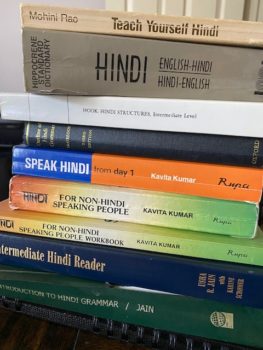Elements of an Effective Hindi Lesson Posted by Nicole Herbert Dean on Dec 17, 2021 in Grammar, Hindi Language, News
Spotting a Good Lesson
What is the most effective प्रभावी way to teach or for that matter learn सीखना Hindi? With the millions of apps, courses पाठ्यक्रम, books and videos out there, how do you pick the proverbial कहावत needle out of the haystack when it comes to learning or for that matter teaching the perfect lesson. Here are some tips when looking for an effective lessonसबक. It should have at least half of the elements listed below.
It is the writer’s belief after years of curriculum writing that the most effective resource संसाधन to build a lesson around is the story. Everyone loves a story. And the more authentic विश्वसनीय it is, the more unforgettable.
The Source
So, the first element is the source – the story, article लेख that is a story कहानी, movie, podcast or book. The content should be in Hindi that is written by authentic Hindi language speakers/writers for Hindi language audiences.
Of course, the basic thing to keep in mind is the level of the content विषय. The United States of America has the ILR scale which is rating scale from 1-5 of language भाषा: हिन्दी levels. 0 is no language while 5 is academic. Therefore if preparing for a state राज्य or government सरकार level test such as the DLPT or OPI, keep that in mind.
Most Hindi news stories are at a level 2 or 2+. Editorials tend to border at 3-3+. Check out this explanation of what this means at the ILR (Interagency Language Roundtable) website. Once determined it is easy to plan the lesson.
It is important to translate the target language article or story into English. This way, the student can always refer back to the transcription प्रतिलिपि to get a backdrop of the story if they do not understand something. If using an audio or video then transcribe and then translate अनुवाद करना. Many students are visual दृश्य and need to see the script.
Brainstorming
First, pick a brainstorming बुद्धिशीलता activity. This can be in the form of a video clip, picture or sound clip of the topic. Ask the student to bring to mind what they think the topic is about. In this way you can encourage activation सक्रियण of prior knowledge. Ask them to write out or draw out their answers.
Speed Read
Secondly, use a quick reading activity. Have the students skim the article लेख briefly, quickly to get the gist of the story without going into the details. This provides a story backdrop or background on which they can build. Remember that Hindi is spoken in many parts of India. To get the authentic meaning of the story understand समझना which region it is set in.
Navigate the Details
After this activity, it is time to start deconstructing the story to get into the details. Break apart each main detail and supporting fact. Multiple choice बहुविकल्पी, true and false as well as match the columns are great activities to test comprehension समझना. There should be at least 3 of these activities.
Summarize it!
Finally, a summarizing activity to test comprehension. Deconstruct the main story into chunks and facilitate construction in sequential order. If the student can effectively put it together? Success!!

Build vocabulary, practice pronunciation, and more with Transparent Language Online. Available anytime, anywhere, on any device.




